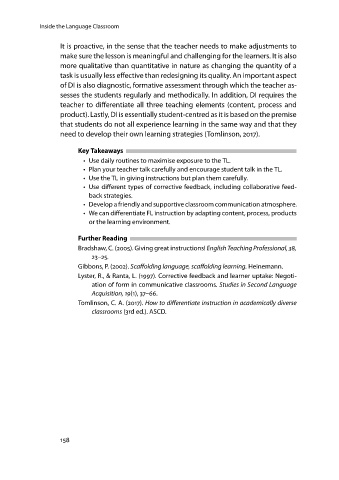Page 158 - Teaching English at Primary Level: From Theory into the Classroom
P. 158
Inside the Language Classroom
It is proactive, in the sense that the teacher needs to make adjustments to
make sure the lesson is meaningful and challenging for the learners. It is also
more qualitative than quantitative in nature as changing the quantity of a
task is usually less effective than redesigning its quality. An important aspect
of DI is also diagnostic, formative assessment through which the teacher as-
sesses the students regularly and methodically. In addition, DI requires the
teacher to differentiate all three teaching elements (content, process and
product). Lastly, DI is essentially student-centred as it is based on the premise
that students do not all experience learning in the same way and that they
need to develop their own learning strategies (Tomlinson, 2017).
Key Takeaways
• Use daily routines to maximise exposure to the TL.
• Plan your teacher talk carefully and encourage student talk in the TL.
• Use the TL in giving instructions but plan them carefully.
• Use different types of corrective feedback, including collaborative feed-
back strategies.
• Develop a friendly and supportive classroom communication atmosphere.
• We can differentiate FL instruction by adapting content, process, products
or the learning environment.
Further Reading
Bradshaw, C. (2005). Giving great instructions! English Teaching Professional, 38,
23–25.
Gibbons, P. (2002). Scaffolding language, scaffolding learning. Heinemann.
Lyster, R., & Ranta, L. (1997). Corrective feedback and learner uptake: Negoti-
ation of form in communicative classrooms. Studies in Second Language
Acquisition, 19(1), 37–66.
Tomlinson, C. A. (2017). How to differentiate instruction in academically diverse
classrooms (3rd ed.). ASCD.
158

